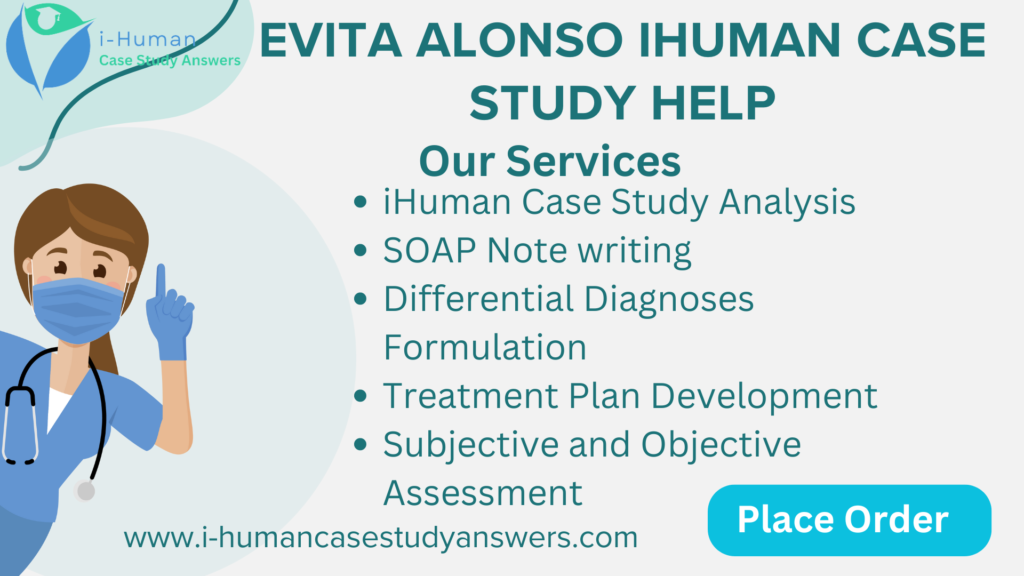Chief Complaint: “Experiencing severe stomach pain over the past 2 weeks.”

History of Present Illness:
Mrs. Alonso, a 48-year-old female, visits the urgent-care clinic with a two-week history of intermittent and progressively worsening right upper quadrant (RUQ) pain. The pain, radiating to the right shoulder, has intensified over the last two days. Accompanying symptoms include nausea, vomiting, and anorexia during the past 48 hours. She reports recurrent, self-resolving symptoms over the past year. Family history is notable for biliary disease (mother). Physical examination reveals low-grade fever, mild scleral icterus, RUQ abdominal tenderness with guarding, and a positive Murphy’s sign.
Onset: 2 weeks ago, with increased severity over the last 2 days.
Location: Right upper quadrant, occasionally radiating to the right shoulder.
Duration: Constant since onset; previously lasted 1-2 days.
Character: Crampy, gnawing, achiness.
Aggravating/Alleviating Factors: Worsens with meals, unaffected by antacids and NSAIDs.
Related Symptoms: Nausea, vomiting, anorexia for the past 2 days. Denies recent exposure to ill contacts. Similar symptoms occurred previously.
Treatments: Over-the-counter antacids and ibuprofen provided no relief.
Significance: Pain scale starts at 2-3, reaching 6-7. Pain hinders work, prompting absence.
Evita Alonso iHuman Case Primary Diagnosis: Ascending Cholangitis
Explanation: Ascendng cholangitis, whether acute or chronic, is caused by gallstones obstructing the gallbladder’s duct. Symptoms include abdominal pain, right shoulder pain, nausea, and vomiting. Hospital admission is recommended due to potential clogged ducts leading to inflammation and infection. Further tests, such as MRCP, may be needed, and a cholecystectomy might be considered. The patient’s family history of biliary disease increases the risk of ascending cholangitis (Crowley & Martin, 2022).
Alternative Diagnoses:
- Cholecystitis:
- Stones blocking the tube between the gallbladder and the small intestine cause cholecystitis. Symptoms include upper-right abdominal pain, nausea, vomiting, fever, and tenderness. The radiating pain to the right shoulder aligns with cholecystitis symptoms (Chatterjee et al., 2022).
- Pancreatitis Acute:
- Inflammation and enlargement of the pancreas lead to acute pancreatitis. Symptoms include nausea, vomiting, fever, abdominal tenderness, and pain radiating to the back. The reported symptoms closely resemble those of acute pancreatitis.
- Peptic Ulcer Disease:
- Developed when digestive tract acid erodes the small intestine or stomach lining. Symptoms involve burning stomach pain, heartburn, nausea, bloating, and heartburn. Considering the reported stomach pain, nausea, and vomiting, peptic ulcers are a plausible diagnosis (Hatnoorkar & Rajpal, 2022).
Evita Alonso iHuman Case: Management Plan
Pharmacologic Care:
- Start IV:
- Initiate intravenous access for immediate intervention.
- Collect blood culture x2:
- Obtain two sets of blood cultures to identify potential infectious agents.
- Give Ertapenem 1g IV:
- Administer intravenous Ertapenem 1g to address potential bacterial infection.
- Consult General Surgery for the Next Steps:
- Seek consultation with General Surgery to determine the necessary surgical interventions.
Evita Alonso Supportive Care- Evita Alonso iHuman Case Study
- Make NPO:
- Ensure the patient remains NPO (Nothing by Mouth) to prevent complications.
- Give 0.9% IV Normal Saline:
- Administer 100ml bolus of 0.9% IV normal saline, followed by 50 ml per hour.
- Give Zosyn 3.375g IV every 6 hours for 7 days:
- Administer intravenous Zosyn every 6 hours for a 7-day course.
- Zofran 4mg IV every 6 hours as needed for nausea/vomiting:
- Provide Zofran intravenously every 6 hours as required for nausea and vomiting.
- Check Blood Glucose Every 4 Hours:
- Monitor blood glucose every 4 hours due to the NPO status, anticipating potential hypoglycemia.
Patient Education:
- Diagnosis Education:
- Educate the patient on the diagnosis, emphasizing the need for ongoing evaluation in the emergency department due to fever and the expected course of treatment. Patient expressed understanding with no further questions.
Follow-Up:
- Alert Staff for Any Concerns:
- Instruct the patient to inform the staff if experiencing increased pain, nausea, fever, lightheadedness, fatigue, or any other needs while in the emergency department.
- Clinic Post-Op Follow-Up (1-2 Weeks After Discharge):
- If the gallbladder is removed, advise the patient to decrease fat in the diet and consume small meals. Avoid strenuous activities or lifting. Take prescribed pain medication.
- Contact Physician for Adequate Pain Control:
- Encourage contacting a physician if pain is not adequately controlled. In case of symptoms like fever/chills or bleeding, prompt contact with urgent care is advised (Chatterjee et al., 2022).
Also Read: i-Human Case Study Answers
References
Chatterjee, S., Mavani, A., & Bhatttacharyya, J. (2022). Chemistry and mechanism of the diseases caused by digestive disorders. In Nutrition and Functional Foods in Boosting Digestion, Metabolism, and Immune Health (pp. 3-14). Academic Press.
Crowley, K., & Martin, K. A. (2022). Patient education: Gallstones (The Basics). UpToDate. Gallstones – UpToDate
Hatnoorkar, S. A., & Rajpal, C. (2022). Homoeopathy and Acid Peptic Disorder. Journal of Medical and Pharmaceutical Innovation, 9(45).
Evita Alonso iHuman Case STUDY: ASSESSING AND MANAGING GENITOURINARY OR GASTROINTESTINAL CONDITIONS
Urinary frequency is a common genitourinary concern affecting individuals throughout their lives. Various systemic conditions, such as diabetes, urinary tract infections, enlarged prostates, kidney infections, or prostate cancer, can contribute to this issue. These conditions necessitate comprehensive patient evaluations to uncover potential serious implications. It is crucial to conduct a thorough assessment of personal, medical, and family history before recommending physical exams and diagnostic testing, weighing the benefits against the associated risks.
Evita Alonso iHuman Case Study Assignment Overview
In this assignment, you will analyze an i-Human simulation case study featuring an adult patient with a gastrointestinal (GI) condition. Your task is to formulate a differential diagnosis, assess treatment options, and develop an appropriate treatment plan based on the provided patient information.
Resources: Ensure you review the Learning Resources for this week, focusing on the assessment, diagnosis, and treatment of patients with GI or GU conditions.
To Prepare:
- Review this week’s Learning Resources to understand the assessment, diagnosis, and treatment of GI or GU conditions.
- Access i-Human from the provided Learning Resources and review the i-Human case study for the week.
- Consider the necessary health history to collect from the patient to inform your evaluation.
- Identify appropriate physical exams and diagnostic tests to gather essential information about the patient’s condition. Reflect on how the results would contribute to a diagnosis.
- Propose three to five possible conditions for consideration in the patient’s differential diagnosis.
- Reflect on clinical guidelines that might support the selected diagnosis.
- Develop a comprehensive treatment plan for the patient, integrating health promotion and patient education strategies tailored to those with GI or GU conditions.
Assignment: Interact with this week’s i-Human patient and complete the assigned case study. Utilize the i-Human Graduate Programs Help link within the i-Human platform for guidance on navigating the platform.
By Day 7:
- Complete your Assignment in i-Human.
- Upload your PDF from i-Human to this assignment.
Submission Information: Before submitting your final assignment, check the draft for authenticity using Turnitin Drafts in the Start Here area. Save your Assignment as WK7Assgn+last name+first initial. Click on Start Assignment, then Upload File, and finally, select Submit Assignment for review.


